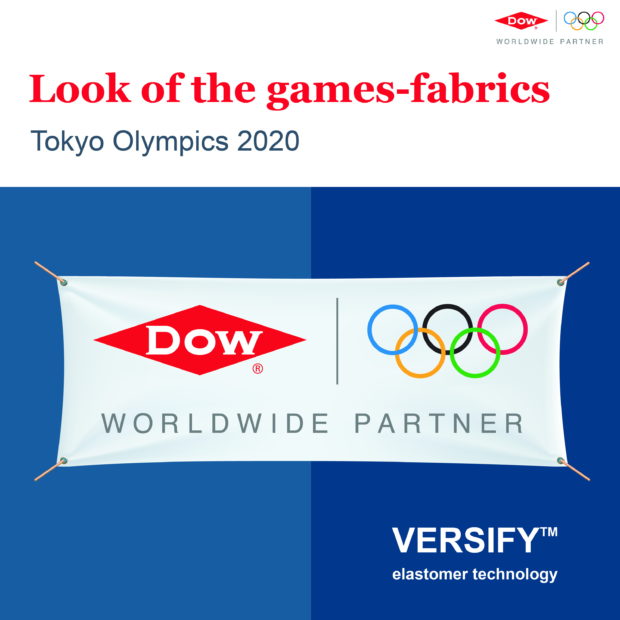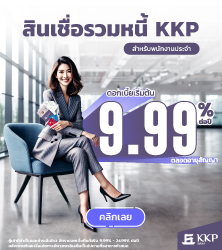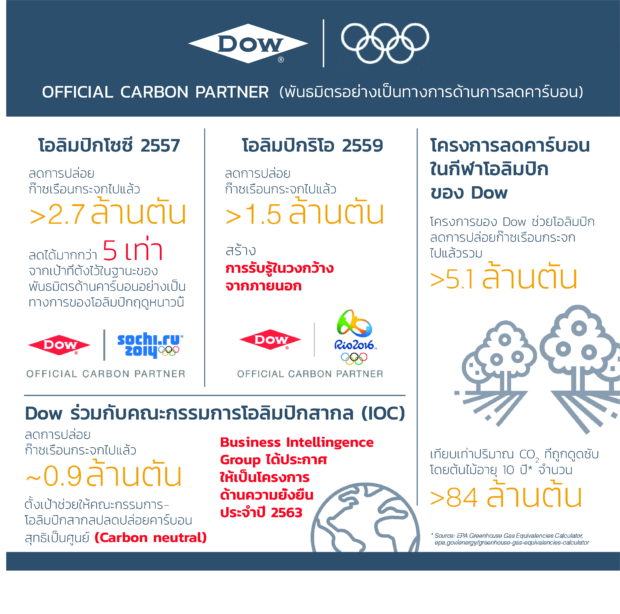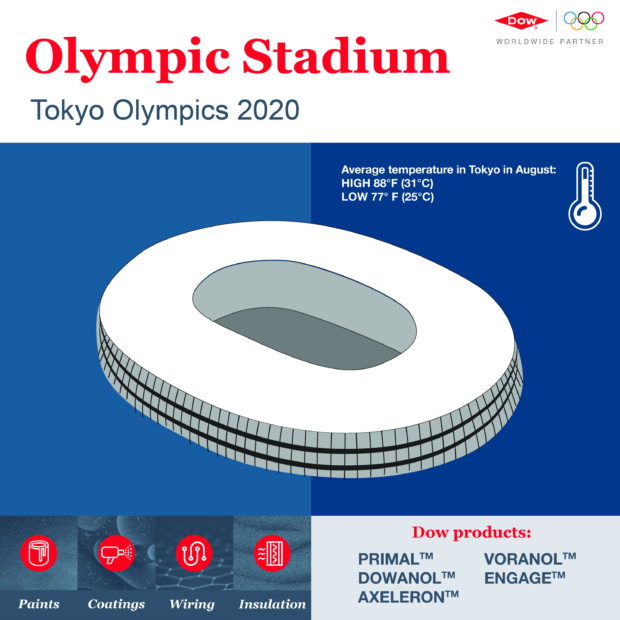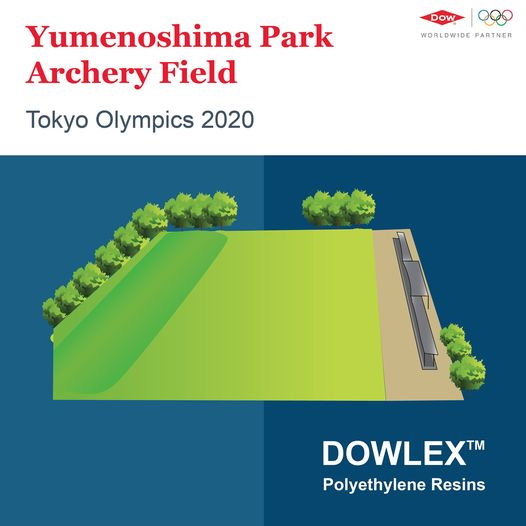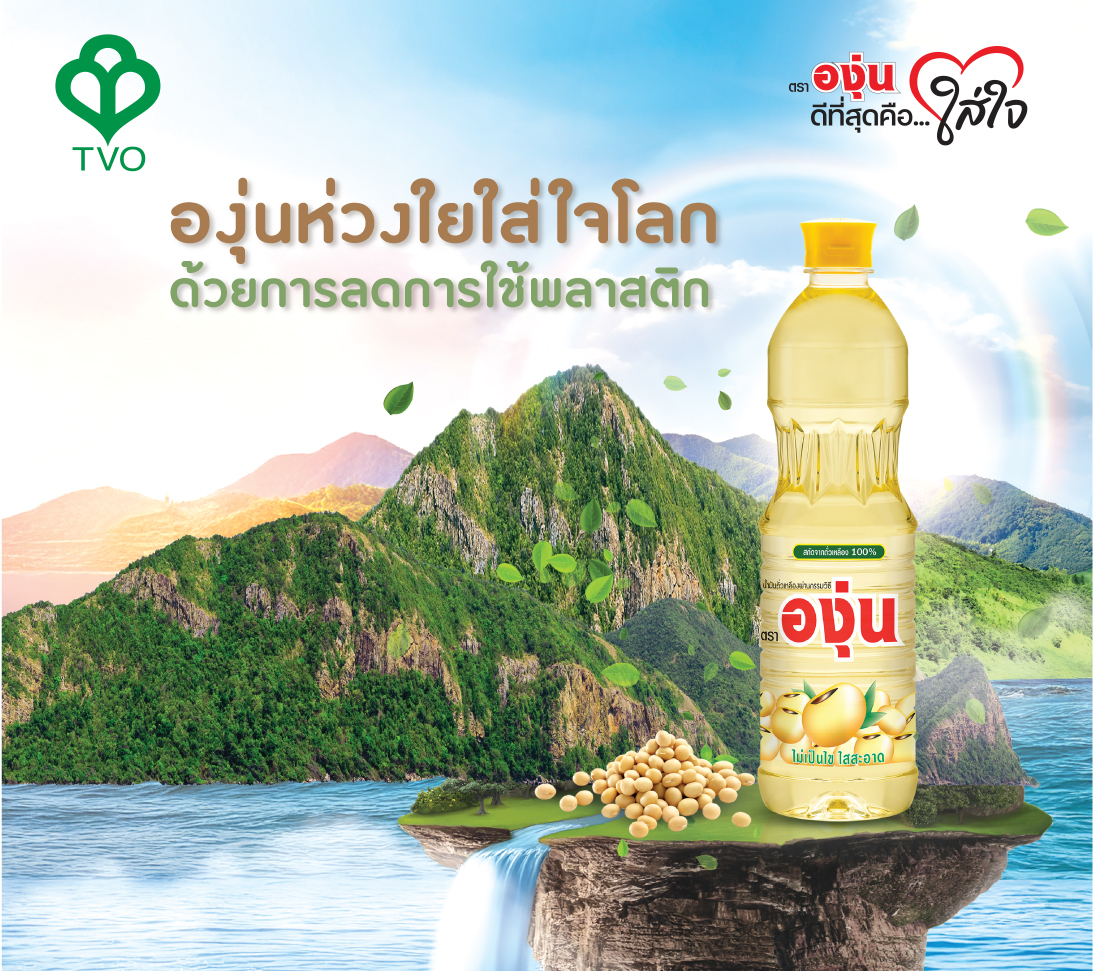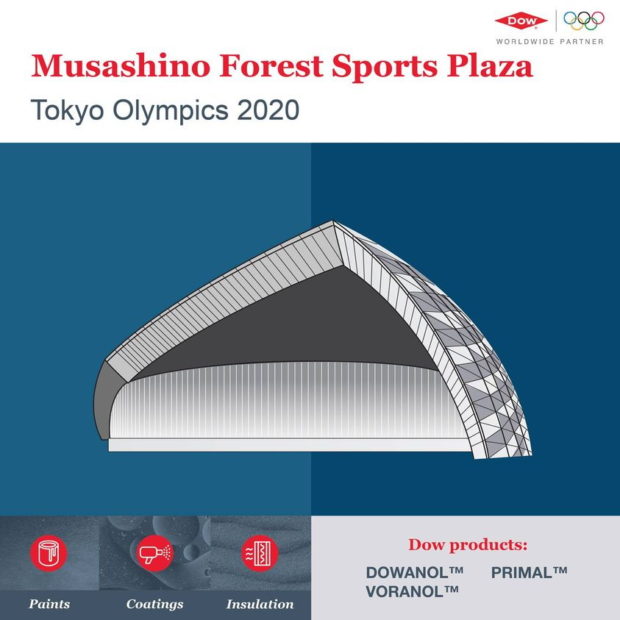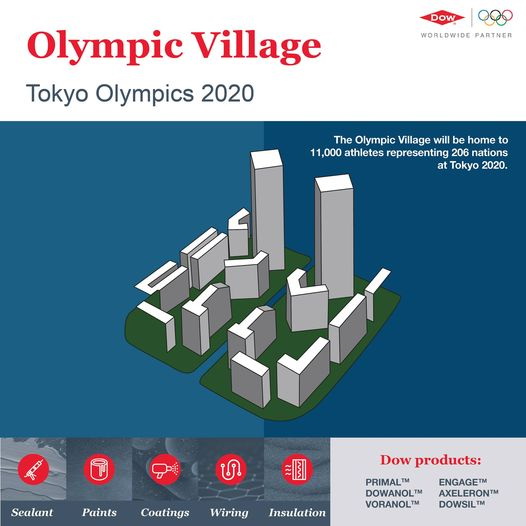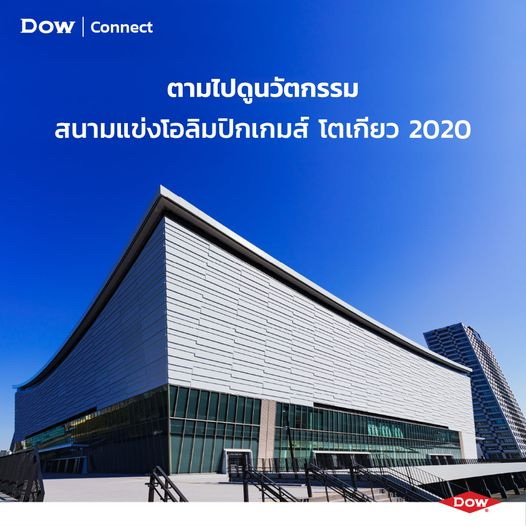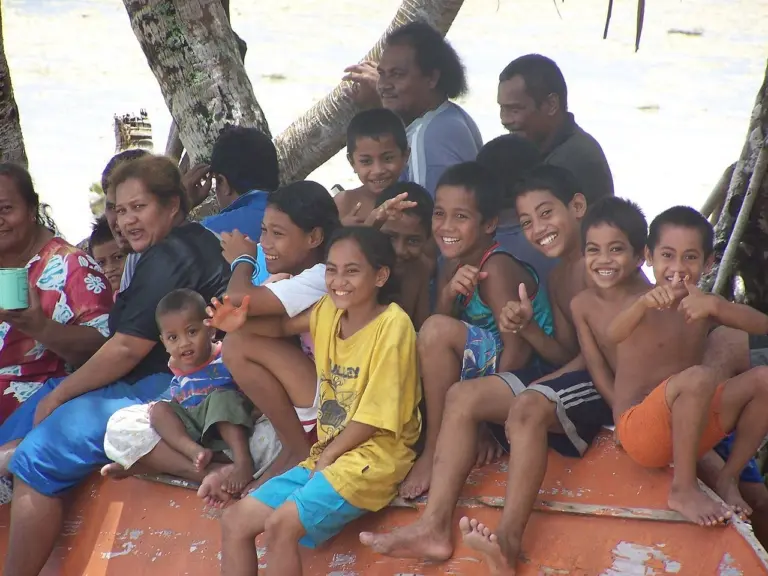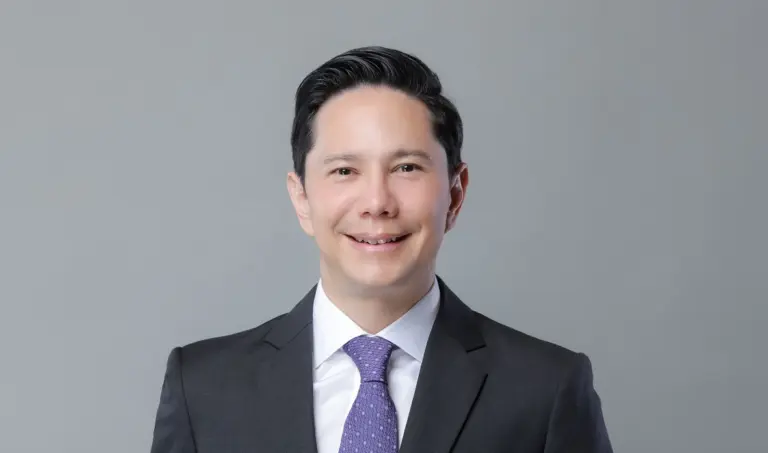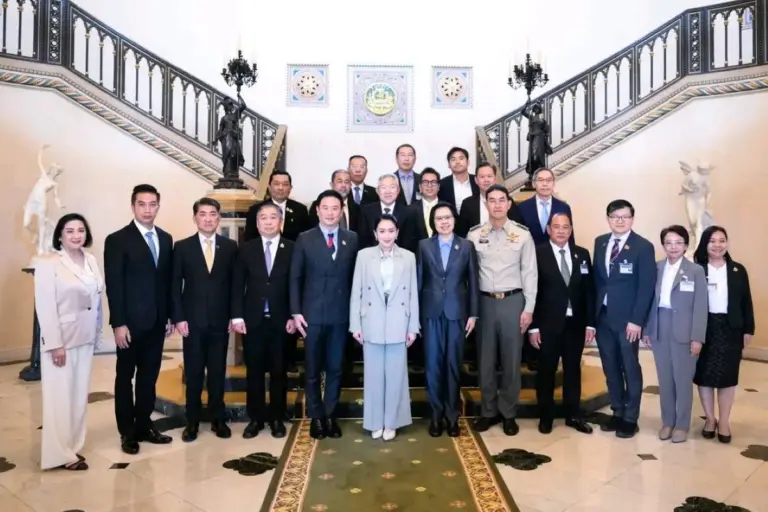Dow ร่วมใช้นวัตกรรมก่อสร้างในสนามโอลิมปิกโตเกียว 2020 มุ่งสู่การกีฬาคาร์บอนต่ำ
3 สิงหาคม 2564 – ในฐานะพันธมิตรอย่างเป็นทางการด้านการลดคาร์บอนของคณะกรรมการโอลิมปิกสากล (IOC) บริษัท Dow ได้นำเสนอผลิตภัณฑ์ขั้นสูงต่าง ๆ ระดับโลกที่มีความยั่งยืนและล้ำหน้า ซึ่งช่วยให้ Dow สามารถปรับปรุงประสบการณ์การแข่งขันกีฬาโอลิมปิกสำหรับเจ้าภาพ นักกีฬา และแฟน ๆ ทั่วโลกทั้งในและนอกสนามแข่งขัน รวมทั้งในชีวิตประจำวัน สำหรับเบื้องหลังของการแข่งขันกีฬาโอลิมปิกกรุงโตเกียวในปีนี้ นวัตกรรมและความเชี่ยวชาญของ Dow มีส่วนสำคัญที่ช่วยสนับสนุนความพยายามในการเพิ่มประสิทธิภาพ ความปลอดภัย และความยั่งยืนของการแข่งขันกีฬาโอลิมปิกและขบวนการโอลิมปิก ให้เป็นไปในทิศทางเดียวกับกลยุทธ์การพัฒนาอย่างยั่งยืนของคณะกรรมการโอลิมปิกสากล (IOC)
การแข่งขันกีฬาระดับโลก อย่างเช่น การแข่งขันกีฬาโอลิมปิกมีการปล่อยก๊าซคาร์บอนไดออกไซด์อย่างมีนัยสำคัญ ทั้งจากการก่อสร้างโครงสร้างพื้นฐานถาวรและชั่วคราว การดำเนินงานด้านต่าง ๆ และการเดินทางของนักกีฬา ผู้ชม และสื่อมวลชน ไปยังการแข่งขัน ทั้งนี้เป็นความรับผิดชอบของคณะกรรมการจัดงานในการวัดแหล่งที่มาของการปล่อยก๊าซเรือนกระจกภายใต้อำนาจหน้าที่ของทีมงาน และลดการปล่อยก๊าซเหล่านี้ให้มากที่สุดเท่าที่จะเป็นไปได้ และกำหนดกลยุทธ์เพื่อสร้างสมดุลของการปล่อยมลพิษที่หลีกเลี่ยงไม่ได้ผ่านความพยายามในการเสริมสร้างสภาพแวดล้อมที่ดีจากที่อื่น ๆ เพื่อให้ผลกระทบของปริมาณคาร์บอนสุทธิของกิจกรรมการแข่งขันเป็นศูนย์ สิ่งนี้แสดงให้เห็นถึงความมุ่งมั่นในการลดปริมาณก๊าซคาร์บอนและความพยายามที่จะทำให้เกมการแข่งขันไม่มีการปล่อยก๊าซเรือนกระจกสู่ชั้นบรรยากาศสุทธิเพิ่มขึ้นจากการดำเนินงานของโอลิมปิก
Dow ใช้ความเชี่ยวชาญด้านวัสดุศาสตร์และกลยุทธ์เชิงรุกในการขับเคลื่อนการตัดสินใจเพื่อสร้างความยั่งยืน และช่วยสร้างพลังบวก รวมถึงมรดกที่จะอยู่คู่สังคมตลอดไป สำหรับการแข่งขันกีฬาโอลิมปิกที่โตเกียว 2020 สิ่งที่เป็นมรดกคือ การรวมสิ่งเก่าเข้ากับสิ่งใหม่ให้เป็นหนึ่งเดียว โดยพิสูจน์ให้เห็นว่าการใช้ประโยชน์จากเทคโนโลยีล่าสุด ช่วยเพิ่มประสิทธิภาพและความยั่งยืนของทิวทัศน์ในกรุงโตเกียวปี 2020 ที่มีสิ่งปลูกสร้างใหม่ รวมถึงย่านต่าง ๆ ในกรุงโตเกียวตั้งแต่ปี ค.ศ. 1964 ก็ได้รับการปรับปรุงใหม่ด้วยเทคโนโลยีด้านอาคารขั้นสูง เพื่อช่วยให้อาคารที่มีอายุมากกว่า 50 ปีขึ้นไปดูล้ำสมัยมากยิ่งขึ้น
เทคโนโลยีของ Dow นั้นอยู่เบื้องหลังของสถานที่หลายแห่ง ทั้งใหม่และที่มีอยู่เดิม เพื่อช่วยป้องกัน ปิดผนึก เชื่อมต่อ เคลือบ ปกป้อง และส่งมอบความยั่งยืนในระยะยาวของอาคารหลังจากพิธีปิดการแข่งขัน มากกว่าครึ่งหนึ่งของสถานที่จัดการแข่งขันกีฬาโอลิมปิกจากทั้งหมด 43 แห่ง เป็นสถานที่เดิมที่มีอยู่แล้ว ช่วยให้สามารถลดปริมาณก๊าซคาร์บอนไดออกไซด์ได้ประมาณ 80,000 ตัน และท่ามกลางอาคารที่มีอยู่แล้ว 9 หลัง ได้รับการปรับปรุงใหม่โดยนำเทคโนโลยีต่าง ๆ ของ Dow มาใช้เพื่อช่วยยกระดับประสิทธิภาพและความสวยงามของส่วนหน้าอาคาร ภายนอกอาคาร และระบบไฟฟ้า ตัวอย่างโซลูชันของ Dow บางส่วนที่ถูกนำมาใช้ประกอบด้วย
- DOWANOL™ ไกลคอลอีเทอร์ (Glycol Ethers) ที่ใช้ในน้ำเป็นตัวทำละลาย จึงมีสารประกอบอินทรีย์ระเหยง่ายในระดับที่ต่ำ ช่วยลดความเสียหายจากความชื้น การแตกร้าว และการผุกร่อน เพื่อให้สถานที่ยังคงดูใหม่
- ELASTENE™ อีลาสโตเมอร์ (Elastomeric) ช่วยปกป้องผนังภายนอกด้วยคุณสมบัติการต้านทานสิ่งสกปรกและน้ำได้ดีเยี่ยม
- อะคริลิคโพลีเมอร์ PRIMAL™ ของ Dow ทำหน้าที่ในการปกป้องผนังภายใน ให้ทนทานในระยะยาวและยึดเกาะดีเยี่ยม
- Dow AXELERON™ เป็นสารประกอบใช้ในชั้นฉนวนในสายโทรคมนาคม ช่วยให้ความเร็วในการส่งและสัญญาณของสนามกีฬามีประสิทธิภาพและวางใจได้มากที่สุด ลดความเสี่ยงของสัญญาณขัดข้อง
นอกจากนี้ ยังมีการใช้สารประกอบ AXELERON™ ร่วมกับ ENGAGE™ โพลิโอเลฟินอีลาสโตเมอร์ (Polyolefin Elastomers) ในการทำชั้นฉนวนสำหรับสายเคเบิลแรงดันต่ำและขนาดกลางที่ยาวกว่า 45 กิโลเมตร เพื่อช่วยส่งกำลังไฟฟ้าที่มีความเสถียรได้ทั่วทั้งอาคาร
- DOWSIL™ SE 797 สารผนึกซิลิโคนที่ถูกใช้ในหลังคาและทางเดินเชื่อมที่เชื่อมโยงศูนย์กระจายเสียงนานาชาติกับศูนย์ข่าวหลัก ทำให้ด้านหน้ากระจกดูโฉบเฉี่ยวโดยไม่มีกรอบโลหะ สารผนึกซิลิโคนมีการยึดเกาะที่ดีเยี่ยมและป้องกันสภาพอากาศ และยังช่วยดูดซับและบรรเทาการเคลื่อนไหวระหว่างองค์ประกอบของโครงสร้าง เพื่อป้องกันการแตกร้าวที่อาจเป็นผลมาจากอุณหภูมิสูงในช่วงฤดูร้อนของโตเกียว
- VORACOR™ โพลียูรีเทนของ Dow ถูกนำไปใช้ในการทำกระดานโต้คลื่น เนื่องจากสามารถขึ้นรูปได้หลากหลายและน้ำหนักเบา มีความหนาแน่นต่ำ แต่มีความแข็งแรงสูง นอกจากนี้ ยังสามารถขึ้นรูปได้ง่ายและทนทาน
- เทคโนโลยีอีลาสโตเมอร์ (Elastomer) VERSIFY™ ได้รับเลือกจาก Toppan Printing มาใช้ในการผลิตเส้นใยโพลิโอเลฟินส์ ซึ่งถูกนำมาใช้ทำป้ายชั่วคราวต่าง ๆ โดยชิ้นส่วนที่เป็นพลาสติกทั้งหมดจะเป็นโพลิโอเลฟินส์เพียงชนิดเดียวเพื่อให้ง่ายต่อการรีไซเคิล
เมื่อการแข่งขันสิ้นสุดลง Dow และ Toppan ตั้งใจที่จะรวบรวมป้ายต่าง ๆ เหล่านี้ เพื่อเปลี่ยนเป็นผลิตภัณฑ์ต่าง ๆ ต่อไป รวมถึงนำมาผ่านกระบวนการให้กลายเป็นเม็ดพลาสติกเพื่อนำมาใช้ใหม่ หรือนำมาผสมกับเศษไม้เพื่อผลิตเป็นวัสดุที่สามารถนำไปทำเป็นม้านั่ง พื้น เป็นต้น
สถานที่จัดการแข่งขันกีฬาโอลิมปิก แสดงให้เห็นมรดกที่น่าภาคภูมิใจของญี่ปุ่น ทั้งมรดกของการแข่งขันกีฬาโอลิมปิกที่โตเกียวในปี ค.ศ. 1964 และอนาคตที่สดใสของการพัฒนาเมืองของกรุงโตเกียว แม้ว่าการแข่งขันกีฬาโอลิมปิกที่ยังคงเรียกว่าโตเกียว 2020 จะถูกเลื่อนออกไปเป็นเดือนกรกฎาคม พ.ศ. 2564 แต่การมุ่งเน้นที่จะสร้างประสบการณ์โอลิมปิกที่ไม่มีใครเทียบได้ เพื่อแฟนกีฬาและนักกีฬายังคงดำเนินต่อไป การปรับปรุงสถานที่ต่าง ๆ สำหรับมหกรรมกีฬาโตเกียว 2020 ซึ่งประกอบด้วยสถานที่ทั้งหมด 43 แห่ง ได้แก่ อาคารก่อสร้างถาวรใหม่ 8 แห่ง สถานที่ที่มีอยู่เดิม 25 แห่ง และสถานที่ชั่วคราวอีก 10 แห่ง ซึ่งได้รับการออกแบบใหม่เพื่อให้ตอบโจทย์การใช้งานของผู้คนในเมืองและผู้อยู่อาศัยในทศวรรษหน้านั้น จะช่วยสร้างเกียรติประวัติศาสตร์ให้กับประเทศญี่ปุ่นต่อไป
นิโคลเลตต้า พิคโคโรวาซซี ผู้อำนวยการฝ่ายเทคโนโลยีและความยั่งยืน และโซลูชันด้านกีฬาและโอลิมปิกของ Dow กล่าวว่า “ความร่วมมือที่เรามีกับคณะกรรมการโอลิมปิกสากล (IOC) เป็นตัวอย่างหนึ่งของความร่วมมือในการพลิกโฉมของการผสานพลังของวิทยาศาสตร์เข้ากับการกีฬา เพื่อกระตุ้นการนำเทคโนโลยีอันล้ำสมัยมาใช้เสริมสร้างสิ่งแวดล้อมที่ดีให้ยังคงอยู่กับคนรุ่นต่อไป เรายกย่องการแข่งขันกีฬาโอลิมปิกว่าเป็น ‘งานแสดงสินค้า’ ที่ใหญ่ที่สุดและทรงพลังที่สุดงานหนึ่งของเรา ซึ่งเป็นทางหนึ่งที่เราสามารถสื่อสารกับลูกค้า ถือเป็นโอกาสครั้งสำคัญที่ลูกค้าจะได้สัมผัสโซลูชันและเห็นวิธีแก้ปัญหาของ Dow โดยตรงที่จัดแสดงในเกมการแข่งขันต่าง ๆ ผ่านอาคารสถานที่ รวมถึงอุปกรณ์และเครื่องแต่งกายสำหรับนักกีฬา”
Dow มีประวัติอันยาวนานกับโลกของกีฬา ในการแข่งขันกีฬาโอลิมปิกปี ค.ศ. 1980 เป็นปีแรกที่ Dow เริ่มจัดหาวัสดุอุปกรณ์ให้แก่สถานที่จัดการแข่งขัน และในช่วง 40 ปีที่ผ่านมา การเป็นพันธมิตรกันนี้ก็ได้พัฒนาและเติบโตจากจุดแข็งไปสู่อีกจุดแข็งหนึ่ง ในปี ค.ศ. 2010 Dow ได้กลายเป็นบริษัทเคมีอย่างเป็นทางการของการแข่งขันกีฬาโอลิมปิก และเป็นส่วนหนึ่งของโครงการ The Olympic Partners (TOP) และในปี ค.ศ. 2017 หลังจากที่ประสบความสำเร็จในการเป็นพันธมิตรด้านคาร์บอนกับคณะกรรมการจัดงานโอลิมปิกที่เมืองโซชีและนครริโอ เด จาเนโร (Sochi and Rio Organizing Committees) คณะกรรมการโอลิมปิกสากลได้แต่งตั้ง Dow ให้เป็นพันธมิตรอย่างเป็นทางการด้านการลดคาร์บอน
……
Olympic Games Tokyo 2020 enhanced by Dow solutions
Bangkok – August 3, 2021 – As the Official Carbon Partner of the International Olympic Committee (IOC), Dow has brought a world-class portfolio of advanced, sustainable and leading-edge products that enable Dow to deliver solutions designed to improve the Olympic experience for host territories, athletes and fans everywhere – on the field of play and in day-to-day lives. Behind the scenes of the Olympic Games Tokyo 2020, Dow’s innovations and expertise are a vital part of efforts to enhance the performance, safety and sustainability of the Olympic Games and the Olympic Movement, in line with the IOC Sustainability Strategy and Olympic Agenda 2020.
Global sporting events such as the Olympic Games have a significant carbon footprint from permanent and temporary infrastructure construction, operations, and the travel of athletes, spectators and media to the Games. It is the responsibility of the Organizing Committee to measure the emission sources under their authority, reduce them as much as possible and devise a strategy to balance the unavoidable emissions through climate benefits generated somewhere else so that the net carbon impact of the event is neutral. This represents both a move toward zero carbon and an effort to make the Games carbon neutral.
That is why Dow is passionate about contributing materials science expertise and proactive strategies that drive sustainable decision-making and helping to power a positive and lasting legacy. For the Olympic Games Tokyo 2020, that legacy includes uniting the old with the new, proving that leveraging the latest technologies enables enhanced performance and sustainability. The Tokyo 2020 cityscape features new construction and also Tokyo 1964 venues that are retrofitted with advanced building technologies to help bring the 50+ year-old facilities to the cutting-edge.
Dow’s technologies are working behind the scenes of many of these venues – new and existing – to help insulate, seal, connect, coat, protect and deliver sustainability gains long after the closing ceremonies. More than half of the 43 Olympic venues are existing facilities, resulting in an estimated savings of 80,000 tons of CO2 equivalent emissions. Among the existing buildings, nine of those that are retrofitted deployed various Dow technologies to help elevate the performance and aesthetic of facades, building envelopes and electrical systems. Some of the Dow solutions implemented include, but are not limited to
- DOWANOL™ Glycol Ethers used in the water-based coatings system helps reduce damage from moisture, cracking and popping to keep the venue looking fresh while meeting low-VOC requirements.
- ELASTENE™ Elastomeric Wall Coatings help shield the exterior walls by providing excellent dirt and water resistance
- Dow’s PRIMAL™ Acrylic Polymer works to protect the interior walls, providing long-term durability and excellent adhesion.
- Dow AXELERON™ Compounds are used as an insulation layer in telecommunication wires to aid in ensuring the stadium’s transmission speeds and signals are as efficient and reliable as possible, reducing the risk of signal loss. AXELERON™ Compounds, and in some cases along with ENGAGE™ Polyolefin Elastomers, are also used as insulation layers for 45 kilometers of low and medium-voltage cables to help provide reliable power throughout the venue.
- DOWSIL™ SE 797 Silicone Sealant is leveraged in the canopy/connecting corridor that links the International Broadcast Center with the Main Press Center, giving the glass façade a sleek look without metal frames. The silicone sealant has excellent adhesion and weather protection, and also helps absorb and relieve movement between the structure’s elements to prevent cracks that could result from Tokyo’s hot summer temperatures.
- Dow’s VORACOR™ Polyurethanes System is leveraged within surfboards due to its shape variety, and lightweight, low density yet high strength profile, in addition to the fact that it’s easy to mold and extremely durable.
- VERSIFY™ Elastomer Technology is selected by Toppan Printing to create a new polyolefin (PO)-based fabric for temporary banners. All plastic parts are comprised only of polyolefins for a purpose of recyclability. Once the events have concluded, Dow and Toppan intend to collect banners and signage that are made with its polyolefin-based materials and upcycle them into different products. Collected banners or signage will be re-palletized as a renewable resin, blended with timber from wood waste to produce wood-plastic composite materials for benches, floors and more.
The Olympic Games venues represent the proud heritage of Japan, the legacy of the Olympic Games Tokyo 1964 and the bright future of Tokyo’s urban development. Although the Olympics Games, still to be called Tokyo 2020, have been postponed to July 2021, the focus on constructing an unparalleled Olympic experience for both fans and athletes continues. Featuring a total of 43 venues – including 8 new permanent structures, 25 existing venues and 10 temporary sites – retrofit venues at Tokyo 2020 honor their history and are reimagined to serve the city and its residents for the next decade and beyond.
Nicoletta Piccolrovazzi, Global Technology & Sustainability Director with Dow Olympic & Sports Solutions, said, “Our carbon partnership with the IOC is an example of one such transformative collaboration, where the platform of sport and the power of science unite to catalyze the adoption of state-of-the-art technologies for a positive climate legacy. We’ve come to recognize the Olympic Games as one of our largest and most powerful ‘trade shows’ which helps guide the way we interact with customers. It is largely an opportunity for customers to experience and witness first-hand Dow solutions that are showcased at the Games, whether they are in venue infrastructure or athlete equipment and apparel.”
Dow has a longstanding history in the world of sports. It was at the 1980 Olympic Games that Dow first started supplying to Games venues. In the 40 years since, the partnership has evolved and grown from strength to strength. In 2010, Dow became the Official Chemistry Company of the Olympic Games and a part of The Olympic Partners (TOP) program, and in 2017, following two successful carbon partnerships with the Sochi and Rio Organizing Committees, the IOC named Dow its Official Carbon Partner.

